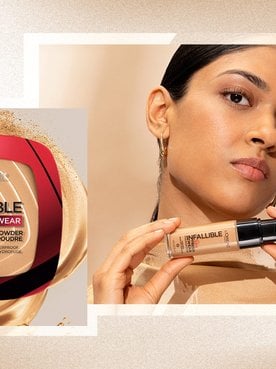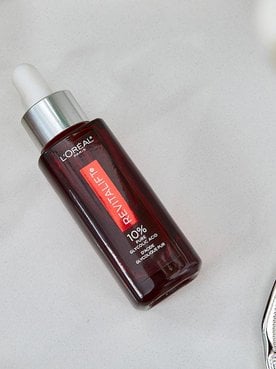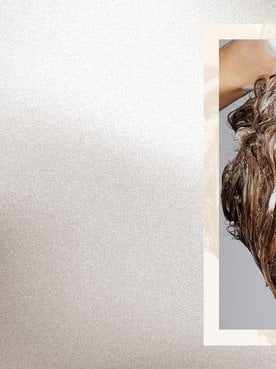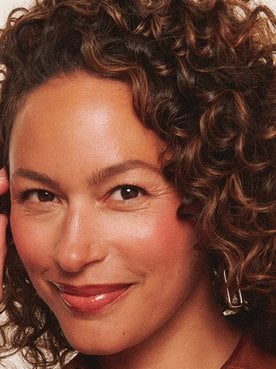Bleaching, coloring, and heat styling your hair can be great ways to express yourself and showcase your unique sense of style. But these habits can also be pretty harsh on your strands—both heat and chemical processing can damage your hair, leaving it brittle and prone to breakage. If you’re a hair styling enthusiast, knowing how to strengthen hair when it’s in less-than-perfect shape can help ensure your tresses look and feel their best, no matter which new look you try.
If you aren’t exactly sure where to start, that’s okay—we’re here to help. Below, we’ll explain how to tell if your hair is weak, share details on what causes brittleness, and reveal how to strengthen your hair via a targeted at-home care routine. Plus, we’ll introduce you to a few of our favorite hair-strengthening products worth adding to your lineup.
What Causes Weak Hair?
If your hair is fragile or brittle, chances are good your styling routine is (at least partly) to blame. Anything that can contribute to damage—from bleaching your hair to flat ironing your tresses without a heat protectant—can leave the hair susceptible to breakage. However, heat and chemical processing aren’t the only habits that can weaken your strands. According to the American Academy of Dermatology (AAD), overwashing your hair, skipping conditioner, or even wearing tight hairstyles can leave your hair fragile and prone to breakage. You don’t have to avoid these things entirely, but limiting how often you subject your strands to damaging stressors can go a long way toward promoting healthier-looking hair.
4 Signs Your Hair Is Weak
You can probably guess what weak hair looks and feels like in comparison to healthy hair—it’s dull, brittle, dry, and noticeably fragile. If you’re still not sure how to know if you have weak hair, keep an eye out for these four common signs of weak hair.
Split ends
Split ends develop when the hair’s outermost layer, called the cuticle, becomes weathered. Minor weathering can simply leave your hair feeling rough or unmanageable. Over time, however, it can cause the ends of the hair to split or fray. If you have a lot of split ends, it’s a sign that your hair is damaged and in need of repair (or a good trim).
Dryness
Your hair needs adequate moisture to stay healthy and resilient. If your tresses lose too much moisture—often thanks to excessive heat styling or chemical processing—they may become dry, fragile, and prone to breakage. Dryness can also contribute to other hair concerns, such as frizz and dullness (so don’t skip that conditioner).
Breakage
Breakage can occur for a number of reasons. If split ends are left unaddressed, the break in the hair shaft can travel further up the strand, causing the hair to snap. Breakage can also occur as a result of bleaching, aggressive styling, friction, or tight hairstyles. No matter the cause, breakage is typically a sign that your hair isn’t as strong or resilient as it should be.
Visible thinning
Most people shed between 50 and 100 hairs per day, according to the AAD. If your hair is weak, however, you may lose more than that, which could lead to visible thinning over time. If you notice you’re losing more hair than you used to or your hair appears thinner than it once did, consider consulting your doctor or dermatologist. They can help pinpoint the cause of your shedding and share expert tips on how to get healthier hair.
How To Strengthen Hair
The best way to strengthen hair is with a targeted haircare routine designed to address, repair, and prevent damage. Keep reading for more details, plus a look at some of our favorite hair-strengthening treatments to try.
Use a bonding system
If stronger hair is your goal, swap out your usual shampoo and conditioner for the L’Oréal Paris EverPure Sulfate-Free Bond Repair Shampoo and L’Oréal Paris EverPure Sulfate-Free Bond Repair Conditioner. This citric acid-powered duo gently cleanses, detangles, and smooths unmanageable hair while helping to strengthen brittle strands from the inside out. For added repair, pre-treat your mane with the L’Oréal Paris EverPure Sulfate-Free Bond Strengthening Pre-Shampoo Treatment. It’s made with a 15% bonding complex with citric acid and helps reinforce weakened hair bonds to support stronger, healthier-looking hair. The system is suitable for all hair types and textures—and it’s one of our go-tos for improving the look and feel of damaged, color-treated hair.

Protect your strands from heat
If you’ve ever accidentally grazed your forehead with a curling iron, you know just how hot your styling tools can get. Though that heat is helpful for achieving long-lasting hairstyles, it can be super hard on your strands. To help strengthen your hair and protect against heat damage, we suggest prepping your strands with a heat protectant any time you plan to blow dry, flat iron, or curl your tresses. The L’Oréal Paris EverPure Bond Repair Oil-in-Serum is a great option for those with weak, brittle hair—it helps protect against temperatures up to 450 degrees Fahrenheit and reinforces weak hair bonds to leave the hair up to seven times stronger. It also helps soften the hair and adds tons of shine without any greasy residue or weigh-down. We’re also big fans of the L’Oréal Paris EverPure Moisture 21-in-1 Leave-In Conditioner for Dry Hair, a lightweight leave-in that detangles, moisturizes, smooths, and helps protect against heat damage.

Shop the Products
Mask weekly
According to the AAD, chemical treatments—like hair coloring and keratin treatments—are some of the most common culprits of hair damage. These processes can strip the hair of essential moisture, leaving the strands weak, brittle, and susceptible to breakage. To help replenish moisture, consider using the L’Oréal Paris Elvive Total Repair 5 Power Restore Multi-Use Treatment in place of your daily rinse-out conditioner once or twice per week. It’s formulated for damaged hair and contains a repair concentrate with proteins to help strengthen hair and protect against future damage. Or, nourish your mane with the L’Oréal Paris Elvive Total Repair 5 Damage-Erasing Balm, a rich, oil-infused mask that helps repair up to one year of damage to hair smoothness within a single use.
How To Prevent Brittle Hair
Once you’ve repaired and strengthened your weak hair, here’s what you need to do to prevent it from happening again.
Keep chemical processing to a minimum
Bleach and hair dye can strip moisture from the hair, which leads to damage. It’s okay to indulge in these practices occasionally, but overdoing it can leave your hair fried, fragile, and frizzy. To help limit damage, consider opting for a bleach-free transformation or opt for balayage highlights instead of all-over color. Additionally, keep an eye on how often you heat style your hair—subjecting already-damaged strands to high temperatures is a recipe for split ends and breakage.
Get regular trims
If you’re prone to split ends, schedule a routine haircut every eight to 12 weeks. This will help to keep the splits under control, which means they won’t move further up the hair shaft and turn into breakage. Note that a trim doesn’t have to mean lobbing off inches at a time—often, a light dusting of the ends is enough to keep split ends at bay.
Detangle with care
Brushing your hair when it’s dry can put your strands under unnecessary stress, which may lead to breakage (especially if you’re tugging at stubborn tangles). Instead, consider detangling your hair while it’s damp and use a wide-toothed comb instead of a brush. Start at the bottom and gradually work your way up the length of your hair to help loosen knots and tangles without pulling at your delicate strands.
Sleep on silk
If you tend to toss and turn while you sleep, consider investing in a silk or satin pillowcase. These materials are slippery, which means your hair can glide over them without snagging the way it might on a cotton or linen pillowcase. If a silk pillowcase is totally out of budget, opt for a satin hair wrap instead—it’ll help protect your tresses from unnecessary friction, which can minimize the chance of damage and breakage.
Opt for loose hairstyles
Tight hairstyles can be harsh on your hair and may lead to breakage or even hair loss if worn frequently. To help protect your mane, alternate between tight and looser hairstyles to give your scalp and strands a break. It’s also a good idea to avoid placing your hair tie in the same spot each time you wear a pony or bun—the repeated pressure from the hair elastic can weaken your hair and cause it to snap.
Next Up: What Is a Keratin Treatment for Hair?
Photo courtesy of L’Oréal Paris







